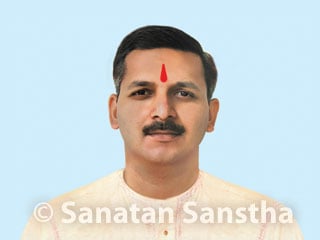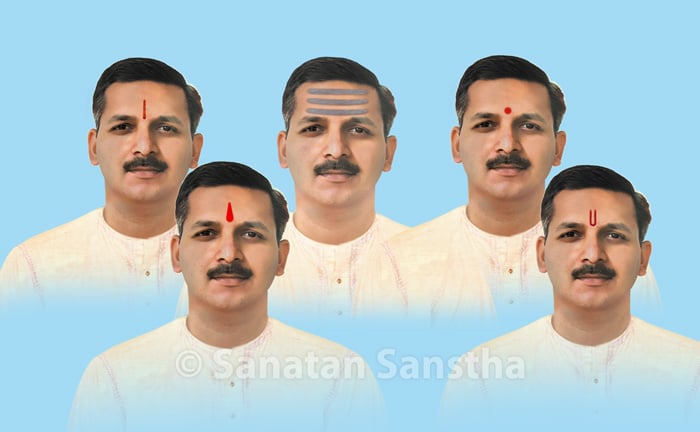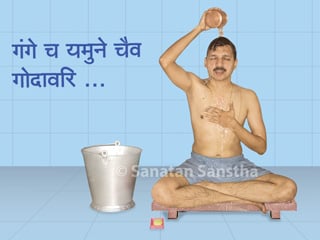After a bath, apply tilak or a mudra (Symbol or a sign) as per sectarian norms. For example, followers of Vaishnav (A sect that worships Shrivishnu) sect apply a vertical tilak, whereas those of Shaiva (A sect that worships Shiva) sect apply three horizontal stripes called ‘tripundra’ to the forehead.
1. Reason for applying tilak to the forehead and tilak meaning
A. Tilak meaning – So long as we are attached to Maya (The Great Illusion), it is advisable to worship the sagun (Materialised) form of Parameshwar (The Supreme God)
The human body is considered to be a temple of God. The Sahasrar chakra is situated on the crown of the head in the region where a choti (Tuft of hair retained while rest of the scalp is shaved) is kept. That is the seat of the Nirgun (Non-Materialised) Parameshwar. Sagun Parameshwar dwells in the mid-brow region. Thus, so long as we are attached to Maya, it is advisable to worship the Sagun form of Parameswar.
B. Tilak meaning – Applying a tilak in the mid-brow region to Parameshwar dwelling there generates devotion and bhav, and imparts Shanti
-
Applying of tilak is a kind of ritualistic worship of God.
-
Scriptures state that we should use the middle finger to apply tilak. Since this finger is associated with the heart, the vibrations flowing through it are carried to the heart. When applying tilak to Parameshwar in the mid-brow region vibrations emanating from the ‘third eye’ present there are carried by it to the heart, thereby generating devotion and bhav (spiritual emotion) in the mind throughout the day and imparting Shanti (serenity).
(Men should practice the above method. Women should use their ring finger to apply kumkum [saffron] to their forehead, and the middle finger to apply it to other women or men).
2. Tilak meaning – Methods of applying tilak or mudra
-
Urdhwapundra : One or more vertical lines drawn on the forehead are called Urdhwapundra. Soil from the places sanctified by Shrivishnu or from the banks of Holy rivers like Ganga, Sindhu, or gopichandan (white clay ) can be used for drawing Urdhvapundra.
-
Tripundra : Three lines drawn horizontally on the forehead with bhasma (Holy ash) are called Tripundra.
A tilak mudra (Symbol or a sign) is drawn with sandal-wood paste.
Reference: Sanatan Sanstha’s Holy Text ‘Daily conduct and science underlying its Acts’



 Waking up early morning and following the achars while still in bed
Waking up early morning and following the achars while still in bed Dinacharya (Daily routine)
Dinacharya (Daily routine) Benefits of bathing - Why should we bathe in the morning ?
Benefits of bathing - Why should we bathe in the morning ? Why do we light lamp in front of deities in the evening ?
Why do we light lamp in front of deities in the evening ? What is the ideal technique of washing clothes ?
What is the ideal technique of washing clothes ? Hindu personal hygiene practices
Hindu personal hygiene practices
Thank you for this information ?